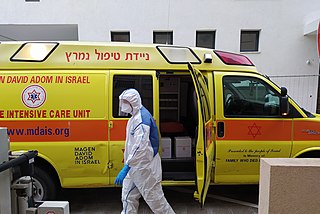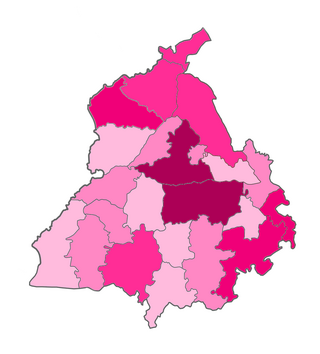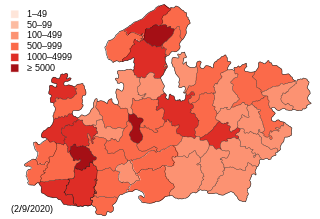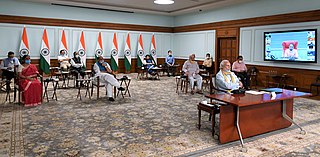
The global COVID-19 pandemic arrived in Europe with its first confirmed case in Bordeaux, France, on 24 January 2020, and subsequently spread widely across the continent. By 17 March 2020, every country in Europe had confirmed a case, and all have reported at least one death, with the exception of Vatican City.

The COVID-19 pandemic in India is a part of the worldwide pandemic of coronavirus disease 2019 caused by severe acute respiratory syndrome coronavirus 2. As of 10 March 2023, according to Indian government figures, India has the second-highest number of confirmed cases in the world with 44,688,367 reported cases of COVID-19 infection and the third-highest number of COVID-19 deaths at 530,775 deaths. In October 2021, the World Health Organization estimated 4.7 million excess deaths, both directly and indirectly related to COVID-19 to have taken place in India.

The COVID-19 pandemic in Israel is part of the worldwide pandemic of coronavirus disease 2019 caused by severe acute respiratory syndrome coronavirus 2. The first case in Israel was confirmed on 21 February 2020, when a female citizen tested positive for COVID-19 at the Sheba Medical Center after return from quarantine on the Diamond Princess ship in Japan. As a result, a 14-day home isolation rule was instituted for anyone who had visited South Korea or Japan, and a ban was placed on non-residents and non-citizens who were in South Korea for 14 days before their arrival.

The COVID-19 pandemic in Lebanon is a part of the ongoing worldwide Coronavirus pandemic, which is caused by severe acute respiratory syndrome coronavirus 2. The virus was confirmed to have reached Lebanon in February 2020.

The COVID-19 pandemic in Pakistan is part of the ongoing pandemic of coronavirus disease 2019 caused by severe acute respiratory syndrome coronavirus 2. The virus was confirmed to have reached Pakistan on 26 February 2020, when two cases were recorded. On 18 March 2020, cases had been registered in all four provinces, the two autonomous territories, and Islamabad Capital Territory, and by 17 June, each district in Pakistan had recorded at least one confirmed case of COVID-19.

National responses to the COVID-19 pandemic have been varied, and have included containment measures such as lockdowns, quarantines, and curfews. As of 10 March 2023, 759,407,939 cases of COVID-19 have been reported, resulting in 6,866,421 reported deaths. The most affected countries in terms of confirmed cases are the United States, Brazil, India, Russia, South Africa, Peru, Mexico, Chile, the United Kingdom, and Iran.
The COVID-19 pandemic was confirmed to have spread to the British Overseas Territory of Gibraltar in March 2020. The first death in Gibraltar occurred on 11 November 2020. As of 18 March 2021, there are 4,270 confirmed cases, 4,146 recoveries, and 94 deaths. As of April 2021, Gibraltar is the first territory where enough of the population has been vaccinated to achieve herd immunity.

The COVID-19 pandemic in Myanmar is part of the worldwide pandemic of coronavirus disease 2019 caused by severe acute respiratory syndrome coronavirus 2. The virus was confirmed to have reached Myanmar on 23 March 2020. On 31 March 2020, the Committee for Coronavirus Disease 19 (COVID-19), headed by First Vice President Myint Swe and made up of members from the various union ministries, was formed by President Win Myint to combat the spread of COVID-19 in the country.
This article documents the timeline of the COVID-19 pandemic in Afghanistan.

The COVID-19 pandemic in Scotland is part of the COVID-19 pandemic of coronavirus disease-2019, caused by the virus SARS-CoV-2. The first case of COVID-19 was confirmed in Scotland on 1 March 2020. Community transmission was first reported on 11 March 2020, and the first confirmed death was on 13 March 2020.
The COVID-19 pandemic in the Isle of Man is part of the worldwide pandemic of coronavirus disease 2019 (COVID-19) caused by severe acute respiratory syndrome coronavirus 2 (SARS-CoV-2). The virus was confirmed to have reached the British crown dependency of the Isle of Man on 19 March 2020, when a man returning from Spain via Liverpool tested positive. Community transmission was first confirmed on 22 March on the island.

The COVID-19 pandemic was confirmed to have spread to the Indian state Punjab on 9 March 2020, when an Indian man returning from Italy was tested positive. As of 31 March 2021, the Ministry of Health and Family Welfare has confirmed a total of 2,39,734 cases, including 6,868 deaths and 2,09,034 recoveries in Punjab. The economy of Punjab has been severely effected by the COVID-19 pandemic.

The first four cases of the COVID-19 pandemic in Jabalpur, Madhya Pradesh were confirmed on March 20, 2020. As of August 14, 2021, Madhya Pradesh has confirmed a total of 791,998 cases, and has recorded 10,514 deaths.

The Indian state governments have responded to the COVID-19 pandemic in India with various declarations of emergency, closure of institutions and public meeting places, and other restrictions intended to contain the spread of the virus.

Countries and territories in South Asia have been affected by the COVID-19 pandemic. The first South Asian country to report a confirmed case was Nepal, which documented its first case on 23 January 2020, in a man who had returned from Wuhan on 9 January. As of 2 July, at least one case of COVID-19 has been reported in every country in South Asia. Afghanistan, Bangladesh, Pakistan and Maldives have implemented lockdowns, Sri Lanka has responded with quarantine curfews while India and Nepal have declared a country-wide lockdown. Countries have also instituted various levels of restrictions on international travel, some countries have completely sealed off their land borders and grounded most international flights.
A Tablighi Jamaat religious congregation that took place in Lahore's Raiwind Markaz in early March 2020 was a COVID-19 super-spreader event with more than 539 confirmed cases linked to the event being reported across the country. Science and Technology Minister Fawad Chaudhry blamed the "stubbornness of the clergy" for the event having gone ahead despite the COVID-19 pandemic.
The National Institute of Virology (NIV) in Pakistan is a national research institute concentrating on biosafety. It has a national laboratory site dedicated to identification and eradication of Emerging infectious diseases, as well as efforts in biological warfare. Aforementioned is a BSL3 laboratory managed by the University of Karachi for the Ministry of Health. Karachi University's International Center for Chemical and Biological Sciences established the National Institute of Virology at September 19, 2019.

The first responses of the government of India to the COVID-19 pandemic in the country involved thermal screenings of passengers arriving from China, the country from which the coronavirus disease 2019 originated, as well as of passengers arriving from other countries. As the pandemic spread worldwide, the Indian government recommended social distancing measures and also initiated travel and entry restrictions. Throughout March 2020, several shutdowns and business closures were initiated, and by the end of the month, the Indian government ordered a widespread lockdown. An economic package was announced in May 2020.

The Hussain Dawood Pledge (HD-Pledge) is one of the biggest private donations and initiatives to fight against the COVID-19 pandemic in Pakistan. Hussain Dawood, on behalf of Engro, Dawood Hercules and his family pledged on 2 April 2020 a contribution in services, kind, and cash of Pakistani rupee (PKR) 1 billion . The contribution became public a day after Prime Minister Imran Khan announced the coronavirus relief fund to fight the pandemic and urged everyone to donate.
Below you can find many detailed tables and graphs that show the historical spread and trends of COVID-19 in Pakistan. Data from 26 February 2020 – 9 March 2020 was taken by compiling news reports about the pandemic in Pakistan that minutely covered the pandemic. From 10 March 2020 – 2 April 2020, data was taken from the NIH's daily reports on COVID-19 that were published from 11 March – 3 April. Since 3 April 2020, data has been taken from the federal government's live tracker. A more detailed list of sources and data covering the national and provincial levels can be found here. Sources regarding the district level can be found in their subsection.













